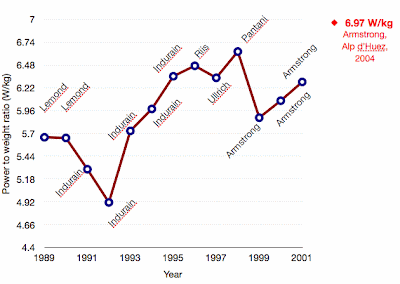acoggan said:
I've had days (TTs) like that as well, yet my power has been unimpaired. That doesn't necessarily mean that cardiac output is reduced, however, since SV may very well increase to compensate.
acoggan, you'll have to forgive my lack of expertise with the details of heart rate and power decoupling. However I struggle to understand your hypothesis that the stroke volume would increase significantly.
In trained athletes, stroke volume increases from around 105ml at rest to 163ml at maximal exercise (a 55% increase). This is compared to a heart rate increases that go from 50 odd bpm to 185 or so bpm (270%) increase.
Furthermore, heart rate and cardiac output are governed by the Frank-Starling law and the Bainbridge reflex. As cardiac output increases, more blood returns to right atrium, stretching the walls of the heart chambers and causing the heart to reflexly contract and eject blood in to the systemic or pulmonary circulation.
All the while, this increased stretch causes increased activation of baroreceptors in the sinus node and causes an increase in heart rate. Then of course stretching of the right atrium also causes the upregulation of the Bainbridge reflex which also increases heart rate.
So any significant increase in stroke volume that is not accompanied by HR rises would have to overcome these reflexes. I suppose its possible via vagal stimulation though? Perhaps due to fatigue...
However for cardiac output to increase significantly enough to supply someone at maximal exercise without heart rate going up much....?
After all, cardiac output and oxygen consumption are dirrectly related. I also assume someone riding at a high power output in a TT will also require significant oxygen consumption, no matter how far you are in to a grand tour. Correct me if I am wrong here.
So if we just assume Chris Froome is an average elite athlete for a moment (by that I mean resting HR of 50 and max of 185) and then we can see what is required for a high cardiac output (lets say 30L per minute) with a low heart rate.
At rest, we can say he is doing 105ml SV X 50bpm which = 5.25L per minute.
At maximal exercise we would have a scenario of 163ml SV X 185bpm = 30.15L per minute.
If he were to have a maximal cardiac output of 30L and average HR of 150bpm, stroke volume would need to be a significant 200ml. Thats a huge variation from a resting stroke volume. While evidence shows that changes in heart rate are responsible for 75% of the increase in oxygen uptake from rest to maximal exertion.
Personally, on days where my HR doesnt get up to the >170bpm range in time trials, I have rather poor power. Conversely, my TTs riden at >190bpm range are usually very good performances. Of course the plural of anecdote is 'no data' though.
I'm not saying its impossible at all, but for your hypothesis to be correct; an increadible variation in stroke volume would need to occur along with the suppression of the bainbridge reflex. I'm not saying you're wrong, I just find this... shall we call it "inverse cardiovascular drift" unlikely.
Or am I not seing the forrest through the trees?






